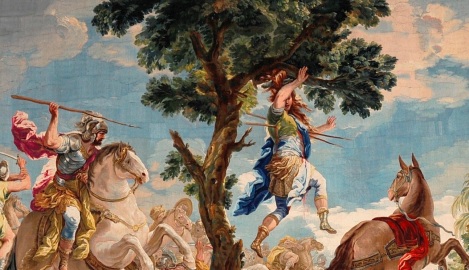At the base of the Mount of Olives, in the valley of Kidron, just outside the city walls of Jerusalem is a striking rock-cut tomb that for centuries has been commonly called, the “Tomb of Absalom”. Passerby would traditionally throw stones at it and fathers of disobedient children would bring them there to show what would happen to rebellious sons.
The attribution of the monument as belonging to Absalom comes from the passage at 2 Samuel 18:18, ” Now Absalom, while he was alive, had taken and set up for himself a pillar in the Valley of the King, for he said: “I have no son to preserve the memory of my name.” So he named the pillar after himself, and it is called Absalom’s Monument to this day.“
The Valley of the King in that verse is taken to be the valley of Kidron, just outside the city walls of old Jerusalem. The first century Jewish historian Josephus reported that Absalom’s Monument was “two stades [370 m; 1,214 ft] distant from Jerusalem.” (Jewish Antiquities, VII, 243 [x, 3]) So the monuments placement in the Valley of Kidron is plausible. But the Biblical and archeological evidence shows that the so-called “Tomb of Absalom” was neither his tomb nor his monument. Two questions arise. How do we know that it couldn’t belong to Absalom and second, if it didn’t belong to Absalom, who did it belong too?

Joab slays Absalom.
According to the account in 2 Kings, when the brief but bloody civil war in the young kingdom had ended, its instigator Absalom was dead and his rival and father King David was in mourning. The vain and entitled Absalom was executed by King David’s military general Joab while he hung by the hair from the branches of a large tree. Absalom was denied a royal burial and thrown into a pit in the forest of Ephraim with stones piled over his body in a “big heap”. (2 Kings 18:17)
The tribal allotment of Ephraim was to the north of Jerusalem and it is logical to assume that the “forest of Ephraim” was in that area as well. Absalom was thus buried far from Jerusalem in the forest of Ephraim proving that the monument near Jerusalem was not his tomb, nor was it intended to be. 2 Samuel 2:18 says the purpose of Absalom’s monument near Jerusalem was to “preserve the memory” of his name. It was a monument to his considerable ego.
Is It Connected To Absalom?
 The archeological evidence shows that the tomb in the Kidron Valley (and it was a originally a tomb) was made during the first century CE, which is approximately 1000 years after the death of Absalom. It survived the destruction of Jerusalem by the Roman’s in 70 C.E, in spite of the fact that the Romans deliberately destroyed Judean monuments like the tombs of the kings and famously, the Temple. It is by far the grandest tomb to survive in the Kidron valley so it is no surprise that centuries later, people misidentified the ancient tomb as Absalom’s Monument.
The archeological evidence shows that the tomb in the Kidron Valley (and it was a originally a tomb) was made during the first century CE, which is approximately 1000 years after the death of Absalom. It survived the destruction of Jerusalem by the Roman’s in 70 C.E, in spite of the fact that the Romans deliberately destroyed Judean monuments like the tombs of the kings and famously, the Temple. It is by far the grandest tomb to survive in the Kidron valley so it is no surprise that centuries later, people misidentified the ancient tomb as Absalom’s Monument.
So if it didn’t belong to Absalom, who did it belong too? Inscriptions on the monument have only deepened the mystery. One inscription discovered in 2003 reads, “This is the tomb of Zachariah, the martyr, the holy priest, the father of John.” This refers to the father of John the Baptist (Luke 1:13). However this is considered to be a “secondary use” inscription from the Byzantine era, written at least 3 centuries later when Christian monks residing in Jerusalem commemorated important figures by attributing a connection between them and existing tombs or structures.

Inside the tomb.
The same goes for another inscription found in 2003 that partially quotes Luke 2:25, “And look! there was a man in Jerusalem named Simeon, and this man was righteous and devout, waiting for Israel’s consolation“. Again the inscription is centuries younger than the monument. Zachariah and Simeon are no more connected to the monument than was Absalom.
The original occupant of the tomb remains a mystery, but a theory proposed in 2013 by a world renowned Israeli archeologist offers a startlingly plausible answer. Dr. Gabriel Barkay proposes that the monument did not belong to Absalom, or Zechariah father of John nor Simeon but it did likely belong to someone else well familiar to Bible students.
To be continued in, “The Mystery of Absalom’s Tomb – Part 2”!
Photo credits:
The tapestry entitled, “The Death of Absalom” was woven in 1817 at the Royal Tapestry Factory in Madrid, under the guidance of its director Don Livinio Stuyck and Vandergoten . {{PD}} Wikimedia Commons
Interior of “Absalom’s Pillar”. Photo by the American Colony (Jerusalem). Matson (G. Eric and Edith) Photograph collection at the Library of Congress. {{PD}} Wikimedia Commons
Other photos by author.

One thought on “The Mystery of “Absalom’s Tomb” – Part 1”